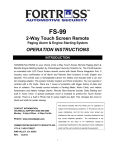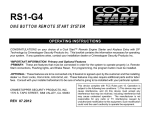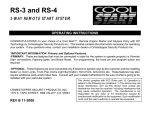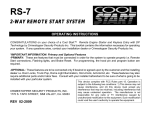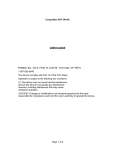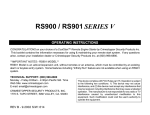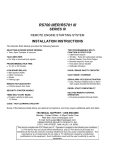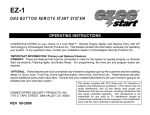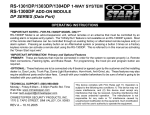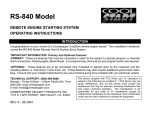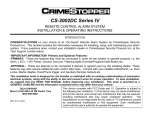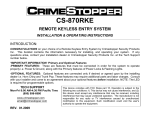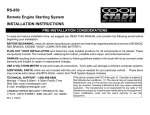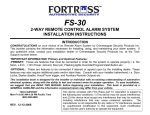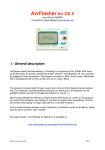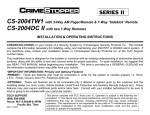Download CrimeStopper FS-99 Installation guide
Transcript
FS-89 FS-99 Alarm Combo System INSTALLATION HANDBOOK: INTRODUCTION Congratulations on your choice of a Crimestopper combination alarm & remote engine starter with animated 3D graphics, 2-Way Data Port for bypass module and Smart Phone Integration port. This installation book is designed for the installer or individual with an existing understanding of automotive electrical systems, along with the ability to test and connect wires for proper operation. To ease installation, we suggest that you READ THIS MANUAL before beginning your installation. This book is provided as a GENERAL GUIDELINE and the information contained herein may differ from your vehicle. DISCLAIMER: Crimestopper Security Products, Inc. and its vendors shall not be liable for any accident resulting from the use of this product. This system is designed to be professionally installed into a vehicle in which all systems and associated components are in perfect working condition. TECHNICAL SUPPORT (800)-998-6880 Monday - Friday 8:00am - 4:30pm Pacific Time Website: www.crimestopper.com CRIMESTOPPER SECURITY PRODUCTS, INC. 1770 S. TAPO STREET SIMI VALLEY, CA. 93063 REV 10.2012 This device complies with FCC Rules part 15. Operation is subject to the following two conditions: 1) This device may not cause interference, and (2) this device must accept any interference that may be received, including interference that may cause undesired operation. The manufacturer is not responsible for any radio or TV interference caused by unauthorized modification to this equipment. Such modification could void the user's authority to operate the equipment. TABLE OF CONTENTS Cautions & Warnings and Component Mounting ..…..………………………………………………………………….……3 Antenna Diagram…….………….…………………………....……………...……………………………………………..……4 5 Pin Connector Wiring – Siren and Lights.…………………....……………...……………………………………………5-6 18 Pin Connector Wiring…….…………………………....……………...…………………………………………..…..…7-12 Shock Sensor…………………………………….........……………...….………..…….……..…………...…………...……13 Power Door Locks.………………………….......………………….……..……………………………………………....14-16 1-Wire Door Locks…….…………………………………………………………………………………………...………17-19 Drivers Door Unlock…………………………..……….………………………………………………….………….…….20-21 Tach Reference…………………………………..…………………………………......…..…….……………...…...……….22 Option Table Programming…………………………………………………………………….…………………...……..23-25 Option Descriptions…..…………………....……………………………………......………………………….………….26-32 Remote Programming………….……………………..………………………………………...…………………...………...33 Alarm and Remote Start Diagnostics………………………………………………………………………………………...34 Main Module Connector Plugs……...………………………………………………………………………………………...35 Manual Transmission Mode…………………………………………………………………………………………………...36 System Wiring Diagram………………………...…………………………………………………………….……………37-38 PR PRE-INSTALLATION CONSIDERATIONS BEFORE BEGINNING, check all vehicle manufacturer cautions and warnings regarding electrical service (AIR BAGS, ABS BRAKES, ENGINE / BODY COMPUTER AND BATTERY). PLAN OUT YOUR INSTALLATION. You should pre-determine the location of the Control Module (Brain), Valet button, LED, and Siren locations. This will save time and ease the installation process. USE VOLT/OHM METER to test and locate all connections. Test Lights or Lighted Probes could possibly damage a vehicle’s computer system or cause an airbag to deploy. ADDITIONAL PARTS, that are not included with this unit, may be needed for your particular vehicle. These items may include extra relays, Door Lock Interface Modules, or Transponder Override modules. 2 CAUTIONS & WARNINGS DAMAGE RESULTING FROM IMPROPER INSTALLATION IS NOT COVERED UNDER WARRANTY!! DO NOT remote start your vehicle in a closed garage. Make sure that the garage door is open or there is adequate ventilation. Failure to observe this rule could result in injury or death from poisonous Carbon Monoxide fumes. DO NOT ROUTE ANY WIRING THAT MAY BECOME ENTANGLED with the brake/gas pedals, steering column, or any other moving parts in the vehicle. REMOVE MAIN SYSTEM FUSE(S) before jump-starting the vehicle or charging the battery at high boost. DAMAGE MAY OCCUR TO SYSTEM IF PROPER PRECAUTIONS ARE NOT OBSERVED. DO NOT exceed the rated output current of any circuit on the Remote start module. Failure to observe this warning will result in damage to the unit. Output currents are listed where applicable throughout this manual. DO NOT extend the Remote start ignition harness length. Mount the module so that main harness reaches all ignition switch wiring. Extending these wires could result in poor performance. COMPONENT MOUNTING CONTROL MODULE: The alarm control module should be mounted in a concealed location. DO NOT mount the control unit in the engine compartment. Fasten the module to a bracket or wire harness using the cable ties provided. SIREN MOUNTING: Mount the siren under the hood to fender-well or other body surface with the open end facing downward. Run the red siren wire through the firewall using a rubber grommet. Ground the black wire to the body metal near the siren. LED: Mount the Blue LED in a visible location on the dashboard or console. ANTENNA TRANSCEIVER: Mount the antenna high up on the front windshield glass. Locate at least 1” away from metal trim or window tint or film OVERRIDE/PROGRAM/VALET BUTTON: Mount the Override/Program push-button in a hidden but accessible location. This button is required for emergency disarm, programming, and valet mode. 3 ANTENNA DIAGRAM ANTENNA MODULE: For optimum range and performance, the antenna/receiver module should be located high up on the front windshield glass. For example: behind the rearview mirror. Note: Window tints or Films may decrease the range of the system. The mounting surface for the antenna should be clean and dry. Note: A call button is located on the antenna to activate the pager. ANTENNA LOCATIONS WINDSHIELD 4 WIRING: 5-PIN Connector Red: Alarm Power Source 5 Amp fuse Connect to 12 volt power source. Red/Black: Parking Light Source 10 Amp Fuse Connects to 12 volts or ground depending on parking light circuit in vehicle Orange: (+) Siren Output Connect brown wire to siren red wire. Connect black wire of siren to chassis ground (body metal). Yellow: Parking Lights – Dual 5 Amp Relay Output (+) 12 Volt Battery 5 AMP FUSE 10 AMP FUSE Red (Alarm) POSITIVE TRIGGER Red/black (Lights) (+) Parking Lights (+) Siren Yellow Orange (+) Parking Lights Yellow 5 WIRING: 5-PIN Connector NEGATIVE TRIGGER (+) 5 AMP FUSE (Alarm) Red 10 AMP FUSE (Lights) Red/black 12 Volt Battery Ground (-) Parking Lights (+) Siren Yellow Orange (-) Parking Lights Yellow 6 WIRING: 18-PIN Connector BLUE/ORANGE: (-) 500mA Starter 2 Output Some vehicles require a 2nd start wire for remote start. BLUE/ORANGE CONNECT TO IGN 85 86 30 87 + BATTERY STARTER ORANGE: (-) 500mA Starter Kill / Anti-Grind Output This wire should be connected to the Black wire of the pre-wired relay socket for the starter disable. Connect the Red wire of the relay socket to the Ignition switched wire on the vehicle. Cut the vehicle starter wire and connect each half to the Yellow and Blue wires on the relay socket as shown. This output also turns on with remote start to function as an “Anti Grind” wire to prevent the starter from grinding if you get in your car and turn the key too far after it was remote started. See starter disable diagram on next page. IGNITION SWITCHED "ON" & HOT THROUGH CRANKING IGN. SWITCHED STARTER WIRE CONNECT TO ORANGE WIRE OF ALARM PRE-WIRED STARTER DISABLE RELAY & SOCKET CUT BLACK STARTER RED YELLOW BLUE START OUTPUT FROM ALARM 6-PIN HARNESS BROWN STARTER DISABLE: 7 MAKE CERTAIN TO CONNECT BROWN WIRE TO STARTER MOTOR SIDE!!! WIRING: 18-PIN Connector Cont. ORANGE/BLACK: (-) 500mA OEM Disarm Output This wire provides a Ground pulse to disarm the vehicles Factory Anti-Theft System prior to a Remote Start. Connect this wire to the vehicles' anti-theft disarm wire. This wire is sometimes found coming off the Driver's door key switch or at the Factory Anti-theft control module. GREEN/RED: (-) 500mA Remote Aux. Output 1 (Programmable Option #10) This is a programmable output that can operate 4 different ways. Channel 1 = Trunk Pop - Default. This is a momentary output as long as the Trunk Button 3 is pressed. NEGATIVE AUXILARY OUTPUT +12V CONSTANT GREEN/RED OR (-) AUX OUTPUT 85 86 30 87 +12V CONSTANT OR * Trunk Soleniod -ORAux Function * Test activation circuit in vehicle. Connect to+12V for Positive circuits or Ground for Negative circuits. Relay not included. 8 WIRING: 18-PIN Connector Cont. BLUE/WHITE: (-) 500mA Remote Aux. Output 2 (Programmable Option #11) This is a programmable output that can operate 4 different ways. 1. Channel 2 = 2nd Unlock Hold 2 Sec. - Default. Hold Unlock Button for 2 seconds to unlock passenger doors. 2. Channel 2 = 2nd Unlock Double Press. Press Unlock button 2 times to unlock passenger doors. 3. Channel 2 = Momentary Hold. This is a momentary output as long as the remote button is pressed. 4. Channel 2 = 30 Second Timer. BLACK/WHITE: (-) 500mA Remote Aux. Output 3 (Programmable Option #12) This is a programmable output that can operate 4 different ways. Channel 3 = Dome Light - Default. For Dome light Supervision with unlock. Negative Dome Light System: Connects to terminal 85 of a relay. Connect terminal 86 to +12V Constant. Connect terminal 87 to Chassis Ground. Connect Terminal 30 to the Negative dome light activation circuit. Positive Dome Light System: Connects to terminal 85 of a relay. Connect terminals 86 & 87 to +12V Constant. Connect terminal 30 to the Positive dome light activation circuit. BROWN/WHITE: (-) 500mA Remote Aux. Output 4 (Programmable Option #13) This is a programmable output that can operate 4 different ways. Channel 4 = Horn Honk - Default. Connect to the Negative Horn Trigger wire usually located near the steering column. If the vehicle horn circuit requires +12 volts, a relay is required. RELAY WIRING: Connect the Brown/White wire to terminal 85, connect relay terminals 86 and 87 to +12V constant power. Connect terminal 30 of the relay to the +12V positive device/circuit to be activated. ORANGE WHITE: (-) 500mA Remote Aux. Output 5 – ACCESSORY or OEM REARM (Programmable Option #14) This is a programmable output that can operate 4 different ways. Channel 5 = Accessory - Default. Controls 2nd Accessory Output for Remote Start. RELAY WIRING: Connect the Orange/White wire to terminal 85, connect relay terminals 86 and 87 to +12V constant power. Connect terminal 30 of the relay to the 2nd Accessory wire of the vehicle. Channel # 5 can be programmed for OEM REARM. This option provides a ground pulse to rearm the vehicles' FACTORY anti-theft system after a timed-out or aborted remote start. Connect this wire to the vehicles' anti-theft rearm wire or to the door pin circuit depending on your requirements. This wire may be needed to pulse the door pin circuit on vehicles with retained accessory power. 9 WIRING: 18-PIN Connector Cont. BLUE/BLACK: (-) 500mA Remote Aux. Output 6 (Programmable Option #15) This is a programmable output that can operate 4 different ways. Channel 6 = Ignition Run - Default. This is used for Remote Start - Ground when Running. This wire functions as a Negative IGNITION OUTPUT (Ground while Remote Starting) for use when connecting factory Security Bypass modules or when an additional external Ignition Relay is required for your installation. BLACK: CHASSIC GROUND Connect to body metal of the vehicle using a sheet metal screw and a star washer to ensure a good ground. Keep the Ground wire short. Scrape away paint or debris from ground location. GRAY: (-) Hood Trigger and Temperature Sensor Input – Zone # 6 Input trigger for a grounding hood pin switch. Connect to an existing hood pin switch that read ground when open. If no existing switches are available, install new pin switches if desired. Note: DO NOT mount new pin switches in water pathways. Locate Temperature Sensor inside vehicle out of direct sunlight. The Temperature Sensor connects to Gray Hood switch input as shown. Temperature Sensor Alarm Plug (-) Hood Switch Gray Wire 10 WIRING: 18-PIN Connector Cont. VIOLET: (+) Door Trigger Input – Zone # 5 Same as the GREEN wire below except this wire is used for vehicles that show a positive voltage (+12 volts) when the door is open and a ground when doors are closed as in many Ford, Lincoln, and Mercury vehicles. GREEN: (-) Door Trigger Input – Zone # 5 Identify the wire that reads ground when any door is open and 12 volts when all doors are closed. Some vehicles may have isolated door triggers. In this case you may need to run additional wires from other doors or go directly to the wire that triggers the vehicle’s interior dome light. Sometimes newer vehicles contain a separate body control module (BCM) where the door trigger circuit can be located. Most vehicles will NOT require the use of BOTH Green and Violet door trigger wires. BLUE: (-) Trunk Trigger Input – Zone # 4 Input trigger for a grounding trunk pin switch. Connect to existing trunk pin switch that read ground when open. If no existing switches are available, install new pin switch if desired. Note: DO NOT mount new pin switches in water pathways. PINK: (-) Start Activation or (+ or -) Diesel Glow Plug The function of this wire is programmable option # 18. • (-) Start Activation Input: This wire allows an outside source or accessory to activate a Remote Start. A momentary ground pulse on this wire will trigger a remote start. Default • (+ or -) Glow Plug circuit using the Pink input wire. When this wire is used, the system will wait until light turns off before engaging the starter. • Fixed 15 second delay (pink wire not used). Most new vehicles have a computer controlled wait to start circuit. There is no wait to start wire, only an indicator light on the dash that is not accessible. These vehicles require a fixed time delay for remote starting. WHIT/RED: TACH INPUT When installing this system in TACH REFERENCE mode, this wire must be connected to a valid source of AC voltage. This wire allows the unit to sense the engine running. This is the most reliable method for remote starting. See Tach Reference Section on Page 22 for more information. 11 WIRING: 18-PIN Connector Cont. BRAKE RESET: There are 2 Brake reset input wires, (+) White and (-) White/black. The White is (+) for the brake pedal. The White/black is for (-) hand brake or emergency brake on manual transmission vehicles. Option # 26 must be activated for the White/black wire to function. White: (+12V) Brake Pedal Reset Connect the White wire to the side of brake pedal switch that shows +12 volts ONLY when pedal is depressed. This will turn off the remote start if someone attempts to drive the car without the keys or if the Ignition key is not turned on all the way. WHITE/BLACK: (-) Hand Brake Reset for Manual Transmission Option #26 – Manual Transmission must be set for the Hand Brake Reset wire to work. Connect the White/black wire to the side of the hand brake that shows (-) ONLY when the hand brake is set. In this mode, the remote start will turn off when the hand brake is released. A Databus module can also supply the Hand Brake status signal on most late model vehicles. Please check Databus module features before connecting hand brake wire. NOTE : May need to diode isolate hand brake to keep feedback from vehicle. 12 WIRING: 4-PIN Shock Sensor (22 Gauge wires) SHOCK SENSOR: There are 2 sensor ports (zone 2 and 3) on the alarm module. The sensor supplied with this system does not require any additional wiring. Simply mount the sensor in a suitable location. It can be tie wrapped to a cable harness or mounted to a plastic panel. Plug sensor into Sensor Plug # 1 for zone 2, and adjust the sensitivity. There are 2 LED’s on the shock sensor to assist you in adjusting sensitivity. The Green LED indicates the “Warn Away” level and the Red LED indicates a full alarm shock sensor violation. The adjustment knob next to Red LED is for trigger. The adjustment knob next to Green LED is for Pre-Warning. Sensor Plug # 2 (Zone # 3) Antenna Plug Sensor Plug # 1 (Zone # 2) Valet Plug Data Plug (Bypass Module) LED Plug Smart Phone Data Plug MAIN MODULE The Sensor Plug #2 is zone 3 for an optional sensor. 13 WIRING: 2-PIN LED / 2-PIN Program-Valet Button (22 gauge wires) Mount LED in a visible location on the Dash or Console. Connect the small 2-pin plug from the LED to the control module. Note: Connectors are designed so that they will only plug into their appropriate slots. Mount the Valet/Program/Override button in a suitable location. Connect the 2-pin plug from the Switch to the control module. Note: Connectors are designed so that they will only plug into their appropriate slots. POWER DOOR LOCKS: WIRING & SYSTEM TYPES DETERMINING DOOR LOCK TYPE: We recommend determining the type of locking system the vehicle has before connecting any wires. Most new vehicles have data controlled door locks and require a data module to interface with the vehicle computer. Please go to the Databus section of the Crimestopper website. Select the type of data module (Fortin or ADS) and it will take you to a vehicle fit guide to determine the best solution for your vehicle. Incorrect connection may result in damage to the alarm and/or vehicle locking system. The system has 2 Built-In relays to interface with most door lock systems. The following door lock information is provided as a guide. Your vehicle may differ. LOCK RELAY: (On-Board Relay) WHITE: Normally Closed (Terminal 87A On-board Lock Relay) GREEN: LOCK Output (Terminal 30 On-board Lock Relay) VIOLET/BLACK (Fused 10A): Normally Open (Terminal 87 On-board Lock Relay) UNLOCK (On-Board Relay): BROWN: Normally Closed (Terminal 87A On-board Unlock Relay) BLUE: UNLOCK Output (Terminal 30 On-board Unlock Relay) VIOLET (Fused 10A): Normally Open (Terminal 87 On-board Unlock Relay) 14 DOOR LOCK WIRING Negative Trigger (-): Many Imports; Late model Ford & General Motors Negative trigger door lock systems send a Negative (Ground) pulse to existing factory relays to lock and unlock the vehicle doors. Positive Trigger (+): Many General Motors; Chrysler / Dodge / Plymouth Positive trigger door lock systems send a Positive (12V) pulse to existing factory relays to lock and unlock the vehicle doors. NEGATIVE TRIGGER POSITIVE TRIGGER Blue Brown White (No Connection) Green Violet Blue White Brown (No Connection) Green Violet/Black Violet Violet/Black + Ground 12 Volts U L Factory Door Lock Module L U + Ground 12 Volts 15 Factory Door Lock Module DOOR LOCK WIRING Reverse Polarity: Many Ford/Lincoln/Mercury/Dodge/Chrysler/Plymouth and early 90’s GM Trucks Reverse Polarity systems use no relays, but instead the door lock/unlock motors are controlled directly from the lock and unlock switches in the door. The lock and unlock wires rest at Negative Ground when not in use. When the lock or unlock button is pressed, one of the circuits is “Lifted” and replaced with +12V causing a lock or unlock to occur. 5 WIRE REVERSE POLARITY Brown AFTER MARKET DOOR LOCKS Blue White Brown Green Violet Blue Green White Violet/Black Violet Violet/Black + 12 Volts (Fused) + Ground U CUT L Factory Door Lock Module + 12 Volts 16 12 Volts (Fused) 1-WIRE RESISTOR DOOR LOCKS Single Wire (Dual Voltage): Late model Chrysler/Dodge/Plymouth Vehicles, some 2000-UP GM Cars Dual Voltage systems have lock/unlock switches that send varying levels of Positive voltage OR Negative ground current to the SAME wire for both lock and unlock. When the vehicle’s Body Computer Module (BCM) or door lock module senses different voltages on this wire, the system will either lock or unlock. Single wire door lock systems require resistors. 1. Locate your vehicle in the chart below to determine the proper resistor value(s), wire color and location. Note: the information is intended as a guide and your vehicle may differ. 2. See chart below for installation. Polarity Lock Resistor Unlock Resistor Wire Color Location Buick Rendezvous 2001-UP Chevy Malibu 2001-UP Chevy Impala, Monte Carlo 2000-UP Neg. Neg. Neg. 470 Ohms None 470 Ohms None 1.5K Ohms None Red / Black White Orange / Black Chrysler 300M, Concord, Intrepid, LHS, 1998-UP Pos. 2.7K Ohms 620 Ohms White / Green Chrysler 300C Chrysler Pacifica Chrysler PT Cruiser 2001-2006 Chrysler PT Cruiser 2001-2006 with alarm Neg. Neg. Neg. Neg. 330 Ohm 1.8K Ohm None 2.7K Ohms 100 Ohm 750 Ohm 1.5K Ohms 7.5K Ohms Chrysler PT Cruiser 2007-UP Neg. None 250 Ohms Pos. 900 Ohm 430 Ohm Violet / Green Violet / Blue White / Green White / Green LT Green/ DK Green LT Green/ Orange BCM at Console Driver’s Kickpanel Driver’s Kickpanel BCM at Driver’s Kickpanel Driver’s Kickpanel Inside Driver’s Door Driver’s Kickpanel Driver’s Kickpanel Pos. 620 Ohms 2.7K Ohms White / Green Pos. 620 Ohms 2.7K Ohms White / Green Pos. 750 Ohms 1.8K Ohms LT Green/ Orange Pos. 1780 Ohms 730K Ohms White / Green Pos. 1780 Ohms 730K Ohms Neg. Neg. Neg. 1.5K Ohms 4020 Ohms 5.2K Ohms 250 Ohms 665 Ohms 2K Ohms Vehicle Chrysler 1995-00 Cirrus, Stratus, Sebring Cont, with alarm Chrysler 1995-00 Cirrus, Stratus, Sebring Cont without alarm Chrysler Sebring and Stratus coupe 2001 without alarm Chrysler Sebring and Stratus coupe 2001 with alarm Chrysler Sebring and Stratus sedan 2001 without alarm Chrysler Sebring and Stratus sedan 2001 with alarm Chrysler Town & Country 1996-2000 without alarm Chrysler Town & Country 1996-2000 with alarm Chrysler Town & Country 2001-06 without alarm 17 LT Green/ Orange White / Green White / Green Violet / Green Driver’s Kickpanel Driver’s Kickpanel BCM at Driver’s Kickpanel BCM at Driver’s Kickpanel BCM at Driver’s Kickpanel BCM at Driver’s Kickpanel BCM at Driver’s Kickpanel Driver’s Kickpanel Driver’s Kickpanel BCM at Firewall Polarity Lock Resistor Unlock Resistor Chrysler Town & Country 2001-06 with alarm Chrysler Voyager 2001-2006 Dodge Caravan 1996-2000 without alarm Dodge Caravan 1996-2000 with alarm Dodge Caravan 2001-06 without alarm Dodge Caravan 2001-06 with alarm Dodge Charger Neg. Neg. Neg. Neg. Neg. Neg. Neg. 2K Ohms 5.3K Ohms 1.5K Ohms 4020 Ohms 5.2K Ohms 2K Ohms 330 Ohm 5.2K Ohms 2K Ohms 250 Ohms 665 Ohms 2K Ohms 5.2K Ohms 100 Ohm Dodge Durango 2000 Neg. 620 Ohms 1.5K Ohms Dodge Durango 2001-02 without alarm Dodge Durango 2001-02 with alarm Dodge Magnum Dodge Neon 2000-UP without alarm Dodge Neon 2000-UP with alarm Dodge Ram Pickup 2002 without alarm Neg. Neg. Neg. Neg. Neg. Neg. 815 Ohms 620 Ohms 330 Ohm None 2.7K Ohms 815 Ohms 315 Ohms 1.5K Ohms 100 Ohm 1.5K Ohms 750 Ohms 315 Ohms Dodge Ram Pickup 2002 with alarm Neg. 2K Ohms 480 Ohms Dodge Ram Pickup 2004 Ford Probe 1990-97 Ford Escape 2001-UP Jeep Liberty 2002-UP Mazda 323 1995 Mazda 626 1998-01 Mazda Millennia 1995-99 Mazda Millennia 2001 Mazda MPV 2000 without alarm Mazda MPV 2000 with alarm Mazda Protégé 1998-03 Mazda Tribute 2001-UP Mercedes Benz SLK230 98-01 Oldsmobile Alero 1999-UP Plymouth Breeze 1996-00 Plymouth Voyager 1996-2000 without alarm Plymouth Voyager 1996-2000 with alarm Pontiac Aztec 2001-UP Pontiac Grand Am 1999-UP Neg. Pos. Neg. Neg. Neg. Neg. Neg. Neg. Neg. Neg. Neg. Neg. Neg. Neg. Pos. Neg. Neg. Neg. Neg. 880 Ohms None 1K Ohm 1.4K Ohm 1K Ohms 1K Ohms 1K Ohms 1K Ohms 2.2K Ohms 2.2K Ohms 1K Ohms 1K Ohm 526 Ohms None 620 Ohms 1.5K Ohms 4020 Ohms 470 Ohms None 280 Ohms 4.7K None 440 Ohm None None None None None None None None None 1.5K Ohms 2.7K Ohms 249 Ohms 665 Ohms None 1.5K Ohms Vehicle 18 Wire Color Location Violet / Blue White / Green White / Green White / Green Violet / Green Violet / Blue Violet / Green LT Green /Orange White / Green White / Orange Violet / Green LT Green LT Green White / Green LT Green/ Orange Violet / LT Blue Green / Black Pink / White Pink / Violet White / Blue Yellow / Green Red / Black White/Blue DK Green LT Green Green / Red Pink / White White / Green White White / Green White / Green White / Green Red / Black White BCM at Firewall Driver’s Kickpanel Driver’s Kickpanel Driver’s Kickpanel BCM at Firewall BCM at Firewall Driver’s Kickpanel Driver’s Kickpanel Driver’s Kickpanel Driver’s Kickpanel Driver’s Kickpanel Driver’s Kickpanel Driver’s Kickpanel Driver’s Kickpanel Driver’s Kickpanel Driver’s Kickpanel Driver’s Kickpanel Driver’s Kickpanel Driver’s Kickpanel Driver’s Kickpanel Driver’s Kickpanel Driver’s Kickpanel Driver’s Kickpanel Pass Kickpanel Pass Kickpanel Driver’s Kickpanel Driver’s Kickpanel Driver’s Kickpanel Driver’s Kickpanel Driver’s Kickpanel Driver’s Kickpanel Driver’s Kickpanel BCM at Console Driver’s Kickpanel 1-WIRE RESISTOR DOOR LOCKS Blue Brown White (No Connection) Green Violet Violet/Black ¼ Watt Resistors Ground Factory Door Lock Module L U Ground 19 SEPARATE DRIVER’S DOOR UNLOCK WIRING NEGATIVE TRIGGER CH 2 Output Program Option #10 2nd Unlock (-) Blue/white + Violet 12 Volts Brown Blue White Green Violet/Black Factory Door Lock Module L U Ground CUT Unlock Wire 20 SEPARATE DRIVER’S DOOR UNLOCK WIRING REVERSE POLARITY Relay CH 2 Output Program Option #10 2nd Unlock (-) Blue/white 86 85 87 87A Brown Blue White Green Violet/Black Violet + 12 Volts L CUT U + CUT CUT Unlock Wire 21 30 + 12 Volts ENGINE MONITORING and TACH REFERENCE MODE This system has 4 methods of monitoring the engine running. Option #1 controls how the system monitors the engine running. 1. The Default is Tachless Low Level. When vehicle is remote started, the battery voltage rate will go up because the Alternator starts working. At Low Level, the battery voltage will need about 0.1 volt increase for remote start success. 2. Tachless High Level - When vehicle is remote started, battery voltage rate will go up because the Alternator starts working. At High Level, the battery voltage will need about 0.4V increase for remote start success. 3. Tach Reference Mode – Monitors Engine R.P.M. - Most reliable method, see Tach programming below. 4. Hybrid Mode – For electric motors that are computer controlled. This provides a 2 second crank output to activate the start sequence on Hybrid vehicle. Don’t use on vehicles with gas or diesel engine, doesn’t monitor stalled engine or low battery voltage. Tach Reference Mode: Provides reliable remote starting performance though engine speed sensing. When using Tach Reference Mode, the WHITE/RED wire is used for Tach signal [Engine RPM] input. Most modern engines include various points where the Engine Speed [Tach] or A/C signal may be obtained. Tach Signal examples: Fuel Injection Solenoids, Negative (-) side of ignition coil, at the Distributor or Ignition Control Module, Coil Pack, Engine Computer, or Crankshaft Sensor. Sometimes an Alternator Stator pin can be used. These Tach Signal locations mentioned are provided as a guide, your vehicle may differ. Some locations will NOT be a good location for Tach source due to RF noise or Computer Data. Note: When using a Databus module for Tach signal, don’t connect up the Tach wire. This will create a conflict. The System can only use one Tach source. TACH PROGRAMMING - Automatically sets option # 1 for Tach with 3.6 second maximum cranking time. 1. Turn On ignition switch. 2. Press Valet / Override button 6 times. After a few seconds the unit will flash the lights and chirp the siren 6 times to confirm. 3. Press Valet / Override button again 1 time. The siren chirps 1 time. 4. Start the vehicle with the ignition key. While the engine is running, the parking will flash to indicate a good Tach source. If they don’t flash, please check tachometer wire connection. 5. To Record RPM, press button 1 on transmitter. System will chirp once to confirm. The Remote control will confirm Tach program. The lights stop flashing. 22 PROGRAMMABLE OPTIONS You can program multiple options in one session if you start with the lowest option and continue on to higher options without repeating steps #1-3 below. For example, you can follow the programming steps to change an Option by pressing button 1 to 4 on the remote, then you can continue pressing the program button additional times to get to a high number option and change the setting without having to repeat Steps 1-5. You can only go from low to higher option numbers in one session. To Engage Option Programming: 1. Turn Ignition Key to the ON position 2. Press Program / Valet button 5 times, after a few seconds the unit will flash the lights and Siren Chirps 5 times. 3. Push the valet/program button [again] the number of times that corresponds to the option number desired (1 thru 30). You must get a light flash and chirp after each button press. 4. When you reach the desired programming level, Press button #1, #2 #3 or #4 to change the option level. The siren and horn will confirm with 1-4 chirps. The remote control will confirm program option selection on top right corner of display. Example option #6 button 4 shows *06--4 5. Turn Ignition OFF and check for changed features. Note: The Program Mode Exits automatically after 20 seconds (lights flash 4 times on exit). 23 PROGRAMMABLE OPTIONS # Option Description TX Button #1 Factory Default TX Button #2 (2 Chirps) TX Button #3 (3 Chirps) TX Button #4 (4 Chirps) 1 Engine Monitoring Tachless Low Level Tachless High Level Engine R.P.M. (Tach) Hybrid Mode 2 Auto lock with Ignition Ignition ON = Lock Ignition OFF = Unlock OFF 3 Open Door Warning 45 Sec. Delay 30 Sec. Delay 15 Sec. Delay 0 Sec. Delay 4 Horn Honk Output Arm/Disarm/ Warning/Trigger Warning and Trigger Trigger Only 5 Auto Rearm / Active Rearm OFF Auto Rearm with Lock Auto Rearm without Lock Active Rearm ON 6 Passive Arming OFF Passive Arm with Lock Passive Arm without Lock OFF with Reminder Chirps 7 Data Port Protocol OFA Series 8 Siren Output Warning and Trigger Trigger Only 9 Pink/white Wire SL Series Arm/Disarm/ Warning/Trigger IGN 2 ACC 2 Start 2 10 Channel 1 Output Green/red wire Trunk Pop (Momentary Hold) 30 Second Timer Latch On/Off Latch On/Off with Ignition Reset 11 Channel 2 Output Blue/white wire 2nd Unlock Hold Button 2 Sec. 2nd Unlock Double Press Momentary Hold 30 Second Timer 12 Channel 3 Output Black/white wire Dome Light 8 Sec. Pulse with Arm for window roll up Momentary Hold 30 Second Timer 13 Channel 4 Output Brown/white wire Horn Honk 8 Sec. Pulse with Arm for window roll up Momentary Hold 30 Second Timer 14 Channel 5 Output Orange/white wire Accessory OEM Rearm Latch On/Off with Ignition Reset Momentary Hold 15 Channel 6 Output Blue/black wire Ignition Run (Ground when Running) Latch On/Off Latch On/Off with Ignition Reset Momentary Hold 24 PROGRAMMABLE OPTIONS 16 17 18 19 Disarm with Trunk Pop Park Lights On with Disarm Pink wire Selection Maximum Crank Time OFF ON ON (30 sec timer) OFF (-) Start Activation 15 Seconds (+) Glow Plug (-) Glow Plug 0.8 Seconds (-) 0.1 Seconds (+) 0.1 Seconds (+) 0.4 Seconds 20 Door Locks 0.8 Sec. Lock / Unlock 3.5 Sec. Lock / Unlock Double Unlock “Wake Up" pulse on Unlock (0.8 sec. +12V to IGN & (-) Run) 21 Remote Start Run Time 20 Minutes 15 Minutes 10 Minutes 5 Minutes 22 3 Chirps on Remote Start Siren OFF Horn Siren & Horn 23 24 Turbo Timer Mode Idle Down OFF 15 Minutes 1 Minute 30 Minutes 6 Minutes Infinity Run 25 Lock with Remote Start Lock with Remote Start OFF 3 Minutes 45 Minutes Lock with Remote Start - Lock / Arm OEM Alarm with Remote Start Abort 26 Transmission Type Automatic Transmission Manual Transmission with Remote Control and Hand Brake 27 Carjack Protection OFF ON 28 29 30 Arm & Disarm thru OEM Remote (Data Mode Only) Unlock before Remote Start Factory Defaults OFF Arm & Disarm OFF ON Manual Transmission with Hand Brake Set Lock / Arm OEM Alarm with Abort Only Manual Transmission with Hand Brake Set (Auto shut down with last door closed 2 sec) Arm / Disarm / Start (3 Press OEM Lock = Remote Start) Press Button 1 to Reset All Options to Default NOTE: The 2-Way remote control will confirm program option selection on top right corner of display. Example option #6 button 4 shows *06--4 25 PROGRAMMABLE OPTION DESCRIPTIONS 1. ENGINE MONITORING: This option controls how the system monitors the engine running. You can program for Tachless mode that monitors battery voltage, Tach mode in which the unit uses a Tach signal (RPM) or for Timed Crank as an alternative. There are 4 choices for this option: 1. Tachless Low Level - Default. When vehicle is remote started, the battery voltage rate will go up because the Alternator starts working. At Low Level, the battery voltage will need about 0.1 volt increase for remote start success. 2. Tachless High Level - When vehicle is remote started, battery voltage rate will go up because the Alternator starts working. At High Level, the battery voltage will need about 0.4V increase for remote start success. 3. Engine R.P.M. (Tach) - Most reliable method. Tach must be programmed for this option to work. 4. Hybrid Mode – For electric motors that are computer controlled. This provides a 3.6 second crank output to activate the start sequence on Hybrid vehicle. Don’t use on vehicles with gas or diesel engine, doesn’t monitor engine running or low battery voltage. Option #19 allows you to shorten starter crank time if necessary. 2. AUTO LOCK with IGNITION: This feature controls whether the doors will automatically lock when the ignition is turned on and unlock when the ignition is turned off. Some vehicles already have this feature from the factory you should turn off this option. Doors will not lock if they are open to prevent locking the keys in. There are 4 choices: 1. Ignition ON = Lock, Ignition OFF = Unlock - Default. 2. OFF = No Lock or Unlock with ignition. 3. OPEN DOOR WARNING: This setting changes the delay time in which the alarm system begins to monitor the Door circuit. This option can prevent the alarm from giving warning chirps on vehicles with a delayed dome light. You can set the time delay for 45, 30, 15 or 0 Seconds. The Default = 45 Seconds. 4. HORN HONK OUTPUT: This option controls whether the Siren and Car Horns Chirp with normal Arm and Disarm. There are 3 choices: 1. Horns Chirp with Arm / Disarm / Warning and Honk with Alarm Trigger - Default. 2. Warning Chirp and Honk with Alarm Trigger (no arm / disarm chirps). 3. Honk with Alarm Trigger only. 26 PROGRAMMABLE OPTIONS Cont. 5. AUTO REARM / ACTICE REARM: The option controls whether the alarm system rearms 30 seconds after disarm. This is handy if the vehicle is accidentally disarmed without your knowledge. There are 4 choices: 1. OFF = Default - No Automatic Rearm in Passive or Active Mode. 2. Auto Rearm with Lock - The alarm system will always rearm and lock the doors after disarm unless the ignition is turned on. This applies to Passive and Active Mode. This choice is best for security but increases the risk of locking the keys in the ignition. 3. Auto Rearm without Lock - The alarm system will always rearm and without locking the doors after disarm unless the ignition is turned on. This applies to Passive and Active Mode. 4. Active Rearm ON – The system will Rearm and lock the doors unless the door, hood or trunk is opened. 6. PASSIVE ARMING: This option is used to automatic arm the alarm system 30 seconds after the ignition is tuned off and the last door is closed. If a door is reopened during the 30 second countdown, the system will wait and begin the countdown again after the door is closed. There are 4 choices: 1. OFF = Default – No Passive Arming. 2. Passive Arm with Lock – The system Locks the doors with Passive Arm. This choice is best for security but increases the risk of locking the keys in the ignition. 3. Passive Arm without Lock – The system Passive Arms without locking the doors. 4. OFF with Arming Reminder Chirps – Passive Arm OFF with the Arming Reminder Chirps 20 seconds after closing last door. 7. DATA PPORT PROTOCOL: This option controls the Data Port Protocol for OFA Series modules or SL Series modules. The default is set for SL Series Protocol. This option has no effect on conventional wiring of Bypass modules. Both OFA series and SL series are 2-Way Protocol. Note: When using a Databus module please check On-Line for latest available software update and installation guide. 27 PROGRAMMABLE OPTIONS Cont. 8. SIREN OUTPUT: This option controls whether the Siren Chirps with Arm / Disarm and Warning. There are 3 choices: 1. Siren Chirps with Arm / Disarm / Warning and Alarm Trigger - Default. 2. Warning Chirps and Alarm Trigger (no arm / disarm chirps). 3. Siren Activates with Alarm Trigger only. 9. PINK / WHITE WIRE SELECTION: This option controls the Pink / White wire function. 1. Pink / White = Ignition 2 - Default. 2. Pink / White = Accessory 2 3. Pink / White = Start 2 10. CHANNEL 1 OUTPUT (Green/red wire): This option controls the function of Green/red wire. 1. Channel 1 = Trunk Pop - Default. This is a momentary output as long as the remote button is pressed. 2. Channel 1 = 30 Second timer. 3. Channel 1 = Latch ON / OFF. 4. Channel 1 = Latch ON / OFF with ignition reset. 11. CHANNEL 2 OUTPUT (Blue/white wire): This option controls the function of the Blue/white wire. 5. Channel 2 = 2nd Unlock Hold 2 Sec. - Default. Hold Unlock Button for 2 seconds to unlock passenger doors. 6. Channel 2 = 2nd Unlock Double Press. Press Unlock button 2 times to unlock passenger doors. 7. Channel 2 = Momentary Hold. This is a momentary output as long as the remote button is pressed. 8. Channel 2 = 30 Second Timer. 12. CHANNEL 3 OUTPUT (Black/white wire): This option controls the function of the Black/white wire. 1. Channel 3 = Dome Light - Default. For 30 second Dome light Supervision with unlock. 2. Channel 3 = 8 Second Pulse with Arm. For activating a window roll up module. 3. Channel 3 = Momentary Hold. This is a momentary output as long as the remote button is pressed. 4. Channel 3 = 30 Second Timer. 28 PROGRAMMABLE OPTIONS Cont. 13. CHANNEL 4 OUTPUT (Brown/white): This option controls the function of the Brown/white wire. 1. Channel 4 = Horn Honk - Default. For Horn Honk output. 2. Channel 4 = 8 Second Pulse with Arm. For activating a window roll up module. 3. Channel 4 = Momentary Hold. This is a momentary output as long as the remote button is pressed. 4. Channel 4 = 30 Second Timer. 14. CHANNEL 5 OUTPUT (Orange/white wire): 1. Channel 5 = Accessory - Default. Controls 2nd Accessory Output for Remote Start. 2. Channel 5 = OEM Rearm. For arming a factory alarm system. 3. Channel 5 = Latch ON / OFF with ignition reset. 4. Channel 5 = Momentary Hold. This is a momentary output as long as the remote button is pressed. 15. CHANNEL 6 OUTPUT (Blue/black wire): This option controls the function of the Blue/black wire. 1. Channel 6 = Ignition Run - Default. This is used for Remote Start Ground when Running. 2. Channel 6 = Latch ON / OFF. 3. Channel 6 = Latch ON / OFF with ignition reset. 4. Channel 6 = Momentary Hold. This is a momentary output as long as the remote button is pressed. 16. DISARM WITH TRUNK POP (Aux 1 Green/red wire): Default = OFF. Controls whether the system will or will not DISARM when the trunk pop or AUX. feature is used. When the feature is turned on the unit will DISARM when opening trunk or using an auxiliary device controlled by the Green/Red wire. 17. PARK LIGHTS ON 30 SECONDS WITH DISARM: Default = ON. Keeps parking lights on when system is disarmed to assist in locating and providing illumination near your vehicle when approaching at night for safety. The parking light also turns off with ignition on. 29 PROGRAMMABLE OPTIONS Cont. 18. PINK WIRE SELECTION: This option is used to change the function of the Pink wire. There are 4 choices for this option: 1. (-) Start Activation - Default. This wire allows an outside source or accessory to activate a Remote Start. A momentary ground pulse on this wire will trigger a remote start. 2. 15 Second Delay - Provides a solution for diesel vehicles without having to connect to the Glow Plug “Wait to Start” input. This may be due to a variety of reasons for example: If your vehicle does not have a “Wait to Start Circuit” or you cannot locate and identify the circuit. 3. (+) Glow Plug – Pink Input Wire must be connected to a positive “Wait to Start Light” (120 second max delay). 4. (-) Glow Plug – Pink Input Wire must be connected to a negative “Wait to Start Light” (120 second max delay). 19. MINIMUN STARTER CRANK TIME: Default = 0.8 seconds This option controls the Minimum Starter Cranking time. This does not affect maximum crank time. This can be adjusted in 0.1 second increments Up or Down from 0.5 to 3.6 seconds. The starter can still crank up to 3.6 seconds with a 0.8 setting, depending on Tach reference. NOTE: The 2-Way remote control will confirm the starter crank time on top right corner of display. TIMED START: Use Hybrid Mode (option 1-4) to set a fixed crank time. Option 19 is used to change the crank time. Please Note: In Hybrid Mode there is only 1 start attempt and the ignition is left on. 20. DOOR LOCKS: This option sets how the door lock circuit works. There are 4 choices: 1. 0.8 Second Lock and Unlock - Default. 2. 3.5 Second Lock and Unlock - For older European vehicles that require a long lock and unlock pulse to operate Vacuum door lock systems. 3. Double Unlock – This feature may be required to interface with a factory alarm or keyless entry system. The first pulse disarms the factory alarm; the 2nd pulse unlocks the doors. 4. “Wake Up” pulse on Unlock - 0.8 second unlock with Ignition pulse to wake up a BCM. This is also called “SLAM LOCK” This feature may be required to interface with a factory alarm or keyless entry system. 30 PROGRAMMABLE OPTIONS Cont. 21. REMOTE START ENGINE RUN TIME: You can set the engine run time for 20, 15, 10 or 5 minutes as desired. Some cities have an unattended vehicle Run Time Limit. Check your local laws. The Default = 20 minutes. 22. CHIRPS WITH REMOTE START ACTIVATION: This option controls whether the system gives 3 short Siren and/or Horn Chirps when activating remote start. There are 4 choices for this option: 1. Siren only – Default 2. OFF 3. Horn only 4. Siren and Horn 23. TURBO TIMER: Using Remote Start Button The optional Turbo Timer mode allows the CoolStart system to keep a Turbo or Turbo Diesel vehicle running for 1, 3 or 6 minutes [selectively] after you remove the key and exit the vehicle. This is handy for turbo cool-down without the need for expensive turbo timers. The Default = OFF. 24. IDLE DOWN: This feature allows the remote starter to take over operation of a parked vehicle when the ignition key is removed and you exit the vehicle. The vehicle will remain running for the programmed time or until canceled. The choices are: 15, 30, 45 minutes or Infinity Run. The Default = 15 minutes. 25. LOCK WITH REMOTE START and REMOTE START ABORT: This option controls whether the unit will automatically lock during and after a remote Start abort or time-out. There are 4 choices for this option: 1. Lock with Remote Start Only- Default. 2. OFF 3. Lock with Remote Start and Lock / Arm with Remote Start Abort. 4. Lock / Arm with Remote Start Abort only 31 PROGRAMMABLE OPTION Cont. 26. TRANSMISSION TYPE: Requires Tach Wire connected and programmed This option selects automatic or manual transmission mode 1. Automatic Transmission – Default. 2. Manual Shift Transmission - Requires Remote Start Button pressed with (-) Hand Brake Activated. 3. Manual Shift Transmission – Starts Exit procedure with (-) Hand Brake Set and engine running. 4. Manual Shift Transmission – System finishes exit procedure automatically. Remote Starter shuts down 2 seconds after closing last door. Not necessary to press remote to set up manual transmission. 27. REMOTE CARJACK: This option is used to enable Carjack Protection. Carjack is enabled by the remote control or Valet button while the ignition is on and the doors are closed. Remote Carjack starts a 30 second countdown to trigger alarm. The Valet button enables Passive Carjack, the door must open and close to start 30 second countdown. The Default = ON. 28. ARM & DISARM thru OEM REMOTE: This option allows the OEM factory remote to Arm, Disarm and Remote Start the system. This feature only works on newer CANBUS vehicle using a Data Module that supports this feature. You can select Arm and Disarm only or Arm, Disarm and Remote Start (requires pressing lock 3 times). Default = OFF. 29. UNLOCK BEFORE REMOTE START: This option is used to disarm an OEM Alarm System before Remote Start. Default = OFF 30. FACTORY DEFAULT: OPTION RESET This resets all options to Factory Default. Press button #1 on the remote control to restore all Factory Defaults. This system option restores all options to FACTORY DEFAULT VALUES as listed in the “Button #1” column of the programmable option chart on pages 24-25. This can be helpful if you have lost track of the option settings on your system, or when you are moving the system from car to car and want a “clean slate”. 32 REMOTE PROGRAMMING DIAGRAM Note: All transmitter codes must be learned at time of programming!! The system learns up to 4 different transmitter codes. 1. Turn Ignition Key to the ON position. (Pink wire must be connected.) 2. Press Programming button 4 times, then after a few seconds the unit Chirps Siren, Horn and Flashes the parking lights 4 times. 3. Press button #1 of the transmitter to be coded. You should get 1 Chirp/Honk indicating the first remote is coded, and then press button #1 of a second transmitter, the unit will Chirp/Honk twice indicating the second remote is coded and so on. If all 4 codes are learned, the unit will automatically exit code learning mode, otherwise turn key off. 4. The system with Chirp/Honk 4 times when exiting learn mode. IGN OFF WAIT FOR 4 FLASHES PRESS 4X's IGN OFF PRESS LOCK CHRIPS 1,2, 3, or 4 X's 33 COMPLETE ALARM TRIGGER DIAGNOSTICS This systems includes disarm diagnostics, through the LED light, that will help in determining what caused the last trigger of the alarm system. This is a valuable tool in determining how the vehicle was tampered with or if there is a false alarm problem in which case you can make the necessary adjustments to correct the problem. When the system is disarmed with the remote you will hear 4 quick chirps that indicate the alarm was triggered while you were away. Check the LED light for a sequence of flashes: Shock Sensor Violation = 2 Flashes Trunk Violation = 4 Flashes Hood Violation = 6 Flashes Sensor 2 Violation = 3 Flashes Door Violation = 5 Flashes Ignition Violation = 7 Flashes Diagnostics will reset when the Ignition is turned on or when the system is re-armed. REMOTE START DIAGNOSTICS If the system doesn’t remote start, the Status LED flashes an error code to identify the problem area. • SOLID LED = Valet Service Mode. Check the systems LED light and if it is on solid Red LED (with doors closed) then the system is in Valet Mode. To exit Valet Mode, turn the Ignition on, press and hold Valet Button for about 5 seconds until LED goes out. Unit is now out of Valet Mode and should perform a remote start. • 2 LED Flashes = Problem with Hood Switch. Make sure hood is closed or that the Blue hood pin wire is not shorted to Ground. • 3 LED Flashes = Problem with Brake Switch. There could be a problem with a bad brake light. Many dual filament light bulbs connect the brake and park lights together when bulb goes bad. Check all brake lights work properly. If using hand brake (normally closed circuit), but sure hand brake is set. • 4 LED Flashes = Low Battery Voltage. Charge vehicle battery. Battery voltage below 11.5 volts. • 5 LED Flashes = Ignition On before Remote Start. • 6 LED Flashes = Tach Problem. Try reprogramming Tach mode, the RPM is too low or high. Move Tach source. • 7 LED Flashes = Manual Transmission Error. • 8 LED Flashes = Diesel Wait to Start Time Out. Check for proper polarity of glow plug circuit. • 9 LED Flashes = Remote Start Failed 4 Times. 34 MODULE CONNECTOR PLUGS Sensor Plug # 2 (Zone # 3) Antenna Plug Sensor Plug # 1 (Zone # 2) Valet Plug Data Plug (Bypass Module) (Fottin or ADS iDatalink LED Plug Smart Phone Data Plug (SM-200) MAIN MODULE Low Current Plug Siren Lights Door Locks 35 High Current Plug Manual Transmission Mode MANUAL TRANSMISSION INSTALLATION: Requires Tach Wire connected and programmed After programming Option #26-2, 26-3 or 26-4 for manual transmission mode, the Door Trigger and Hand Brake wire must be connected for the manual transmission remote start procedure. A Databus module can also supply the Door and Hand Brake status signal on most late model vehicles. Please check Databus module features before connecting door and hand brake wires. A door opening will now cancel a remote start that was previously “set-up” by the user. The Hand Brake and Door Trigger is a safety feature to cancel a remote start. Note: You can’t use the interior lights as a door trigger if the interior lights turn on with ignition off. MANUAL TRANSMISSION EXIT PROCEDURE: 1. Option 26-2: With engine running and vehicle in neutral, set parking brake, then press “Idle Down” Icon or remote start on transmitter. The remote starter will turn on and take over operation of the vehicle. 2. Option 26-3: With engine running and vehicle in neutral, set parking brake. The remote starter will turn on and take over operation of the vehicle. 3. Remove key, exit vehicle (remote starter unit must “SEE” door opened, then closed with engine running). 4. Press Lock button within 10 seconds of closing door to arm system with “Idle Down” (engine stays running). Press Lock a 2nd time to cancel “Idle Down” (engine turns off) and set up Manual Transmission Mode. 5. Press Lock button after 10 seconds to Arm system, lock the doors and shut down the engine. From this point, the system will remote start the engine unless a door is opened or the alarm is triggered (either function will cancel the remote start sequence).\ 6. Option 26-4: With engine running and vehicle in neutral, set parking brake, the remote starter will turn on and take over operation of the vehicle. Remove Key and exit vehicle. When the last door of vehicle is closed, the engine will turn off in 2 seconds and set up Manual Transmission Mode. You can arm the alarm system to lock doors and protect vehicle. Note: Turbo Timer in Manual Transmission Mode. The engine will remain running for the Turbo Time setting after the alarm is armed. 36 WIRING: 6-PIN High Current Connector Diagram not to scale. For illustration purposes only. Your vehicle may be different (-) Brown STARTER (+) 12 Volt Battery Fuse Red Fuse Red Fuel Pump Pink Coil Pink/White Gray START IGN IGNITION 2 ACC IGN 2 P.C.M. A/C - Heater Control NOTE! Use External Relays for High Current Ignition and/or Accessory circuits greater than 30A. Failure to do so could result in damage to the unit that is not covered under warranty. **** Fuse Holders Wire Connections should NOT GET HOT **** 37 IGNITION SWITCH WIRING DIAGRAM Dome Light or AUX Output 30 86 87 87A 85 (-) CH 3 Output Horn Honk or AUX Output 30 86 87 87A 85 (-) CH 4 Output (-) CH 1 Output Brown/white Green/red Accessory OEM Rearm AUX Output 30 86 87 87A 85 (-) CH 5 Output Ignition RUN or AUX Output 30 86 87 87A 85 (-) CH 6 Output 3 Blue/white Black/white Orange/black 86 30 87 85 87A 2nd Unlock or AUX Output 30 87 85 87A Trunk Pop or AUX Output 86 (-) OEM Disarm Orange/white Orange (-) Kill Output Blue/black Black Ground TACH 4 5 (-) CH 2 Output 6 Blue/orange (-) Start 2 Pink (-) Glow Plug (-) Brake White/Black (-) Hand Brake 7 2 1 8 0 ENGINE MONITOR White/red (-) Hood Trigger (-) Hood Switch (+) Brake Gray White Brake Pedal (+) Door Trigger (+)Door Switch Purple (-) Trunk Trigger Blue (-) Door Trigger (-) Door Switch NOTE: USE ONLY ONE BRAKE INPUT Green 38 (-) Trunk Switch DATA PORT This unit includes DP Technology that will allow you to directly Plug-In our Data Port Bypass Modules. There are 2 types of Protocol, ADS/OFA series and EVO/SL series modules. The default is set for EVO/SL series Protocol. Please refer to Databus module manual for detail instructions. The Data Port Protocol must be programmed for the correct module. See Option # 7 on page 24 for programming Data Port Most new vehicles require a Databus Module to Bypass the factory Immobilizer and operate the keyless entry Databus modules are used to communicate with the vehicles computer at the OBD2 Data connector or Canbus wires. This reduces installation error. Crimestopper Systems with DP Series have a direct Data Port Plug-In for the Databus bypass module. This eliminates conventional wiring between the Alarm/Remote Starter and the bypass interface module. Features Include • • • • • • • • • • • • • • • Transponder Immobilizer. PassLock Immobilizer. O.E.M. Alarm Control. R.A.P. Shutdown. Power Door Locks. Priority Unlock. Trunk Release. Parking Lights. Courtesy Lights. Brake Pedal and Hand Brake Hood, Door and Trunk Status Tachometer. Heated Seats. Rear Defrost. Driver 1 and 2 Memory presets. The actual features controlled depend on the vehicle and Databus module. www.crimestopper.com Phone (800) 998-6880 FAX (805) 581-9500 ONLINE TECHNICAL SUPPORT www.crimestopper.com © 2012 Crimestopper Security Products 40








































